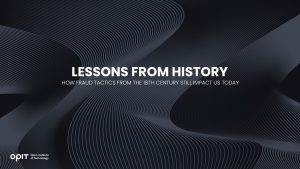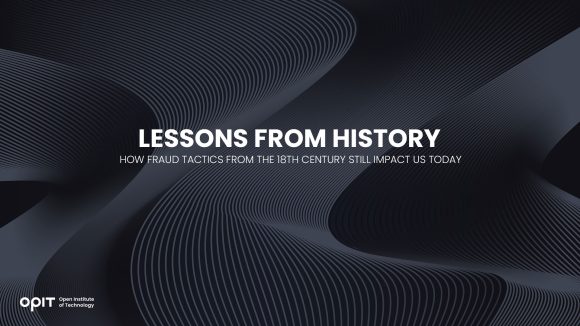

Many people treat cyber threats and digital fraud as a new phenomenon that only appeared with the development of the internet. But fraud – intentional deceit to manipulate a victim – has always existed; it is just the tools that have changed.
In a recent online course for the Open Institute of Technology (OPIT), AI & Cybersecurity Strategist Tom Vazdar, chair of OPIT’s Master’s Degree in Enterprise Cybersecurity, demonstrated the striking parallels between some of the famous fraud cases of the 18th century and modern cyber fraud.
Why does the history of fraud matter?
Primarily because the psychology and fraud tactics have remained consistent over the centuries. While cybersecurity is a tool that can combat modern digital fraud threats, no defense strategy will be successful without addressing the underlying psychology and tactics.
These historical fraud cases Vazdar addresses offer valuable lessons for current and future cybersecurity approaches.
The South Sea Bubble (1720)
The South Sea Bubble was one of the first stock market crashes in history. While it may not have had the same far-reaching consequences as the Black Thursday crash of 1929 or the 2008 crash, it shows how fraud can lead to stock market bubbles and advantages for insider traders.
The South Sea Company was a British company that emerged to monopolize trade with the Spanish colonies in South America. The company promised investors significant returns but provided no evidence of its activities. This saw the stock prices grow from £100 to £1,000 in a matter of months, then crash when the company’s weakness was revealed.
Many people lost a significant amount of money, including Sir Isaac Newton, prompting the statement, “I can calculate the movement of the stars, but not the madness of men.“
Investors often have no way to verify a company’s claim, making stock markets a fertile ground for manipulation and fraud since their inception. When one party has more information than another, it creates the opportunity for fraud. This can be seen today in Ponzi schemes, tech stock bubbles driven by manipulative media coverage, and initial cryptocurrency offerings.
The Diamond Necklace Affair (1784-1785)
The Diamond Necklace Affair is an infamous incident of fraud linked to the French Revolution. An early example of identity theft, it also demonstrates that the harm caused by such a crime can go far beyond financial.
A French aristocrat named Jeanne de la Mont convinced Cardinal Louis-René-Édouard, Prince de Rohan into thinking that he was buying a valuable diamond necklace on behalf of Queen Marie Antoinette. De la Mont forged letters from the queen and even had someone impersonate her for a meeting, all while convincing the cardinal of the need for secrecy. The cardinal overlooked several questionable issues because he believed he would gain political benefit from the transaction.
When the scheme finally exposed, it damaged Marie Antoinette’s reputation, despite her lack of involvement in the deception. The story reinforced the public perception of her as a frivolous aristocrat living off the labor of the people. This contributed to the overall resentment of the aristocracy that erupted in the French Revolution and likely played a role in Marie Antoinette’s death. Had she not been seen as frivolous, she might have been allowed to live after her husband’s death.
Today, impersonation scams work in similar ways. For example, a fraudster might forge communication from a CEO to convince employees to release funds or take some other action. The risk of this is only increasing with improved technology such as deepfakes.
Spanish Prisoner Scam (Late 1700s)
The Spanish Prisoner Scam will probably sound very familiar to anyone who received a “Nigerian prince” email in the early 2000s.
Victims received letters from a “wealthy Spanish prisoner” who needed their help to access his fortune. If they sent money to facilitate his escape and travel, he would reward them with greater riches when he regained his fortune. This was only one of many similar scams in the 1700s, often involving follow-up requests for additional payments before the scammer disappeared.
While the “Nigerian prince” scam received enough publicity that it became almost unbelievable that people could fall for it, if done well, these can be psychologically sophisticated scams. The stories play on people’s emotions, get them invested in the person, and enamor them with the idea of being someone helpful and important. A compelling narrative can diminish someone’s critical thinking and cause them to ignore red flags.
Today, these scams are more likely to take the form of inheritance fraud or a lottery scam, where, again, a person has to pay an advance fee to unlock a much bigger reward, playing on the common desire for easy money.
Evolution of Fraud
These examples make it clear that fraud is nothing new and that effective tactics have thrived over the centuries. Technology simply opens up new opportunities for fraud.
While 18th-century scammers had to rely on face-to-face contact and fraudulent letters, in the 19th century they could leverage the telegraph for “urgent” communication and newspaper ads to reach broader audiences. In the 20th century, there were telephones and television ads. Today, there are email, social media, and deepfakes, with new technologies emerging daily.
Rather than quack doctors offering miracle cures, we see online health scams selling diet pills and antiaging products. Rather than impersonating real people, we see fake social media accounts and catfishing. Fraudulent sites convince people to enter their bank details rather than asking them to send money. The anonymity of the digital world protects perpetrators.
But despite the technology changing, the underlying psychology that makes scams successful remains the same:
- Greed and the desire for easy money
- Fear of missing out and the belief that a response is urgent
- Social pressure to “keep up with the Joneses” and the “Bandwagon Effect”
- Trust in authority without verification
Therefore, the best protection against scams remains the same: critical thinking and skepticism, not technology.
Responding to Fraud
In conclusion, Vazdar shared a series of steps that people should take to protect themselves against fraud:
- Think before you click.
- Beware of secrecy and urgency.
- Verify identities.
- If it seems too good to be true, be skeptical.
- Use available security tools.
Those security tools have changed over time and will continue to change, but the underlying steps for identifying and preventing fraud remain the same.
For more insights from Vazdar and other experts in the field, consider enrolling in highly specialized and comprehensive programs like OPIT’s Enterprise Security Master’s program.
Related posts

Source:
- Metro, published on October 09th, 2025
After ChatGPT came on the scene in 2022, the tech industry quickly began comparing the arrival of AI to the dawn of the internet in the 1990s.
Back then, dot-com whizzes were minting easy millions only for the bubble to burst in 2000 when interest rates were hiked. Investors sold off their holdings, companies went bust and people lost their jobs.
Now central bank officials are worried that the AI industry may see a similar boom and bust.
A record of the Financial Policy Committee’s October 2 meeting shows officials saying financial market evaluations of AI ‘appear stretched’.
‘This, when combined with increasing concentration within market indices, leaves equity markets particularly exposed should expectations around the impact of AI become less optimistic,’ they added.
AI-focused stocks are mainly in US markets but as so many investors across the world have bought into it, a fallout would be felt globally.
ChatGPT creator OpenAI, chip-maker Nvidia and cloud service firm Oracle are among the AI poster companies being priced big this year.
Earnings are ‘comparable to the peak of the dot-com bubble’, committee members said.
Factors like limited resources – think power-hungry data centres, utilities and software that companies are spending billions on – and the unpredictability of the world’s politics could lead to a drop in stock prices, called a ‘correction’.
In other words, the committee said, investors may be ignoring how risky AI technology is.
Metro spoke with nearly a dozen financial analysts, AI experts and stock researchers about whether AI will suffer a similar fate. There were mixed feelings.
‘Every bubble starts with a story people want to believe,’ says Dat Ngo, of the trading guide, Vetted Prop Firms.
‘In the late 90s, it was the internet. Today, it’s artificial intelligence. The parallels are hard to ignore: skyrocketing stock prices, endless hype and companies investing billions before fully proving their business models.
‘The Bank of England’s warning isn’t alarmist – it’s realistic. When too much capital chases the same dream, expectations outpace results and corrections follow.’
Dr Alessia Paccagnini, an associate Professor from the University College Dublin’s Michael Smurfit Graduate Business School, says that companies are spending £300billion annually on AI infrastructure, while shoppers are spending $12billion. That’s a big difference.
Tech firms listed in the US now represent 30% of New York’s stock index, S&P 500 Index, the highest proportion in 50 years.
‘As a worst-case scenario, if the bubble does burst, the immediate consequences would be severe – a sharp market correction could wipe trillions from stock valuations, hitting retirement accounts and pension funds hard,’ Dr Paccagnini adds.
‘In my opinion, we should be worried, but being prepared could help us avoid the worst outcomes.’
One reason a correction would be so bad is because of how tangled-up the AI world is, says George Sweeney, an investing expert at the personal finance website site Finder.
‘If it fails to meet the lofty expectations, we could see an almighty unravelling of the AI hype that spooks markets, leading to a serious correction,’ he says.
Despite scepticism, AI feels like it’s everywhere these days, from dog bowls and fridges to toothbrushes and bird feeders.
And it might continue that way for a while, even if not as enthusiastically as before, says Professor Filip Bialy, who specialises in computer science and AI ethics at the at Open Institute of Technology.
‘TAI hype – an overly optimistic view of the technological and economic potential of the current paradigm of AI – contributes to the growth of the bubble,’ he says.
‘However, the hype may end not with the burst of the bubble but rather with a more mature understanding of the technology.’
Some stock researchers worry that the AI boom could lose steam when the companies spending billions on the tech see profits dip.
The AI analytic company Qlik found that only one in 10 business say their AI initiatives are seeing sizeable returns.
Qlik’s chief strategy officer, James Fisher, says this doesn’t show that the hype for AI is bursting, ‘but how businesses look at AI is changing’.

OPIT – Open Institute of Technology offers an innovative and exciting way to learn about technology. It offers a range of bachelor’s and master’s programs, plus a Foundation Year program for those taking the first steps towards higher education. Through its blend of instruction-based and independent learning, it empowers ambitious minds with the skills and knowledge needed to succeed.
This guide covers all you need to know to join OPIT and start your educational journey.
Introducing the Open Institute of Technology
Before we dig into the nitty-gritty of the OPIT application process, here’s a brief introduction to OPIT.
OPIT is a fully accredited Higher Education Institution under the European Qualification Framework (EQF) and the MFHEA Authority. It offers exclusively online education in English to an international community of students. With a winning team of top professors and a specific focus on computer science, it trains the technology leaders of tomorrow.
Some of the unique elements that characterize OPIT’s approach include:
- No final exams. Instead, students undergo progressive assessments over time
- A job-oriented, practical focus on the courses
- 24/7 support, including AI assistance and student communities, so everyone feels supported
- A strong network of company connections, unlocking doors for graduates
Reasons to Join OPIT
There are many reasons for ambitious students and aspiring tech professionals to study with OPIT.
Firstly, since all the study takes place online, it’s a very flexible and pleasant way to learn. Students don’t feel the usual pressures or suffer the same constraints they would at a physical college or university. They can attend from anywhere, including their own homes, and study at a pace that suits them.
OPIT is also a specialist in the technology field. It only offers courses focused on tech and computer science, with a team of professors and tutors who lead the way in these topics. This ensures that students get high-caliber learning opportunities in this specific sector.
Learning at OPIT is also hands-on and applicable to real-world situations, despite taking place online. Students are not just taught core skills and knowledge, but are also shown how to apply those skills and knowledge in their future careers.
In addition, OPIT strives to make technology education as accessible, inclusive, and affordable as possible. Entry requirements are relatively relaxed, fees are fair, and students from around the world are welcome here.
What You Need to Know About Joining OPIT
Now you know why it’s worth joining OPIT, let’s take a closer look at how to go about it. The following sections will cover how to apply to OPIT, entry requirements, and fees.
The OPIT Application Process
Unsurprisingly for an online-only institution, the application process for OPIT is all online, too. Users can submit the relevant documents and information on their computers from the comfort of their homes.
- Visit the official OPIT site and click the “Apply now” button to get started, filling out the relevant forms.
- Upload your supporting documents. These can include your CV, as well as certificates to prove your past educational accomplishments and level of English.
- Take part in an interview. This should last no more than 30 minutes. It’s a chance for you to talk about your ambitions and background, and to ask questions you might have about OPIT.
That’s it. Once you complete the above steps, you will be admitted to your chosen course and can start enjoying OPIT education once the first term begins. You’ll need to sign your admissions contract and pay the relevant fees, then begin classes.
Entry Requirements for OPIT Courses
OPIT offers a small curated collection of courses, each with its own requirements. You can consult the relevant pages on the official OPIT site to find out the exact details.
For the Foundation Program, for example, you simply need an MQF/EQF Level 3 or equivalent qualification. You also need to demonstrate a minimum B2 level of English comprehension.
For the BSc in Digital Business, applicants should have a higher secondary school leaving certificate, plus B2-level English comprehension. You can also support your application with a credit transfer from previous studies or relevant work experience.
Overall, the requirements are simple, and it’s most important for applicants to be ambitious and eager to build successful careers in the world of technology. Those who are driven and committed will get the best from OPIT’s instruction.
Fees and Flexible Payments at OPIT
As mentioned above, OPIT makes technological education accessible and affordable for all. Its tuition fees cover all relevant teaching materials, and there are no hidden costs or extras. The institute also offers flexible payment options for those with different budgets.
Again, exact fees vary depending on which course you want to take, so it’s important to consult the specific info for each one. You can pay in advance to enjoy 10% off the final cost, or refer a friend to also obtain a discount.
In addition to this, OPIT offers need-based and merit-based scholarships. Successful candidates can obtain discounts of up to 40% on bachelor’s and master’s tuition fees. This can substantially bring the term cost of each program down, making OPIT education even more accessible.
Credit Transfers and Experience
Those who are entering OPIT with pre-existing work experience or relevant academic achievements can benefit from the credit transfer program. This allows you to potentially skip certain modules or even entire semesters if you already have relevant experience in those fields.
OPIT is flexible and fair in terms of recognizing prior learning. So, as long as you can prove your credentials and experience, this could be a beneficial option for you. The easiest way to find out more and get started is to email the OPIT team directly.
Join OPIT Today
Overall, the process to join OPIT is designed to be as easy and stress-free as possible. Everything from the initial application forms to the interview and admission process is straightforward. Requirements and fees are flexible, so people in different situations and from different backgrounds can get the education they want. Reach out to OPIT today to take your first steps to tech success.
Have questions?
Visit our FAQ page or get in touch with us!
Write us at +39 335 576 0263
Get in touch at hello@opit.com
Talk to one of our Study Advisors
We are international
We can speak in:


